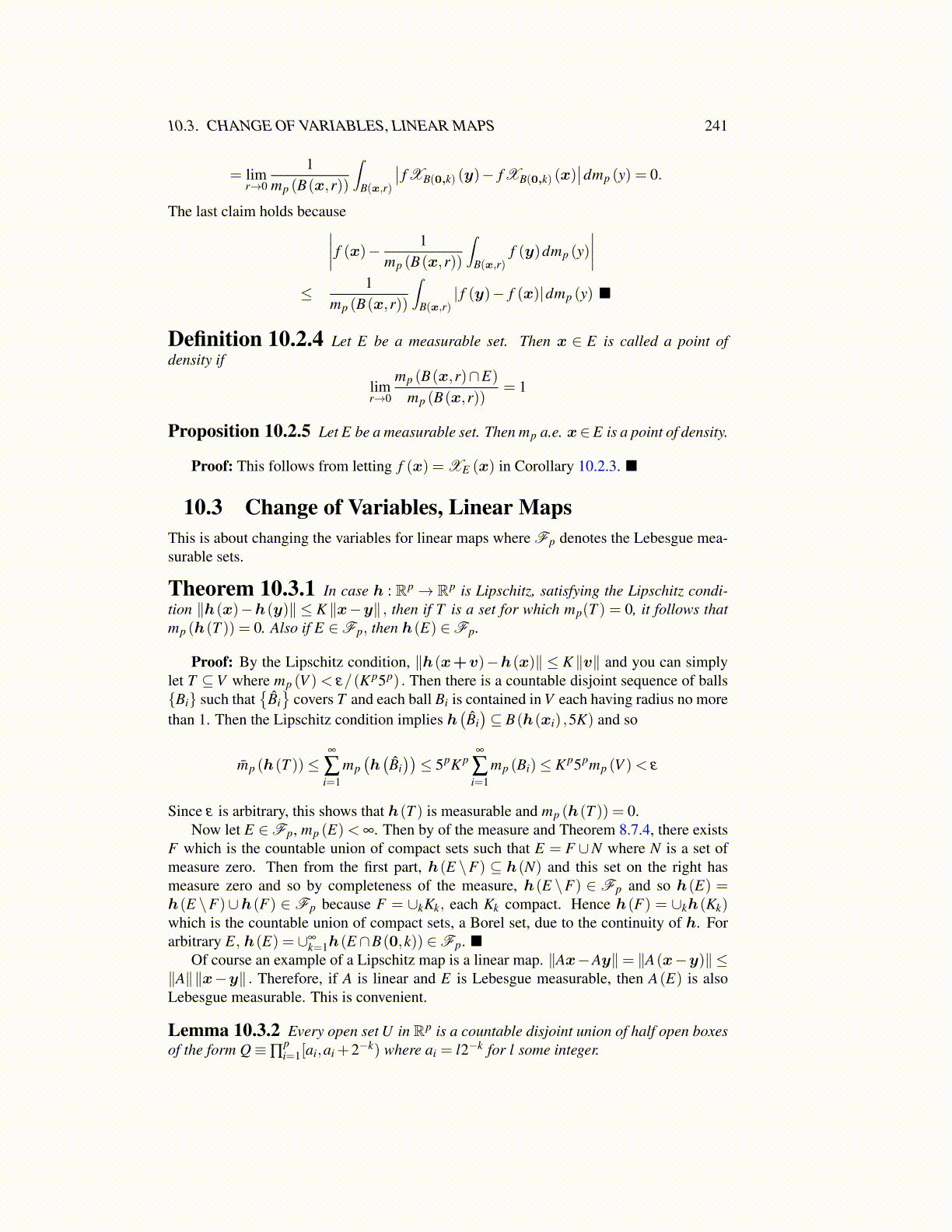
10.3. CHANGE OF VARIABLES, LINEAR MAPS 241
= limr→0
1mp (B(x,r))
∫B(x,r)
∣∣ f XB(0,k) (y)− f XB(0,k) (x)∣∣dmp (y) = 0.
The last claim holds because∣∣∣∣ f (x)− 1mp (B(x,r))
∫B(x,r)
f (y)dmp (y)∣∣∣∣
≤ 1mp (B(x,r))
∫B(x,r)
| f (y)− f (x)|dmp (y) ■
Definition 10.2.4 Let E be a measurable set. Then x ∈ E is called a point ofdensity if
limr→0
mp (B(x,r)∩E)mp (B(x,r))
= 1
Proposition 10.2.5 Let E be a measurable set. Then mp a.e. x∈E is a point of density.
Proof: This follows from letting f (x) = XE (x) in Corollary 10.2.3. ■
10.3 Change of Variables, Linear MapsThis is about changing the variables for linear maps where Fp denotes the Lebesgue mea-surable sets.
Theorem 10.3.1 In case h : Rp → Rp is Lipschitz, satisfying the Lipschitz condi-tion ∥h(x)−h(y)∥ ≤ K ∥x−y∥ , then if T is a set for which mp(T ) = 0, it follows thatmp (h(T )) = 0. Also if E ∈Fp, then h(E) ∈Fp.
Proof: By the Lipschitz condition, ∥h(x+v)−h(x)∥ ≤ K ∥v∥ and you can simplylet T ⊆V where mp (V )< ε/(K p5p) . Then there is a countable disjoint sequence of balls{Bi} such that
{B̂i}
covers T and each ball Bi is contained in V each having radius no morethan 1. Then the Lipschitz condition implies h
(B̂i)⊆ B(h(xi) ,5K) and so
m̄p (h(T ))≤∞
∑i=1
mp(h(B̂i))≤ 5pK p
∞
∑i=1
mp (Bi)≤ K p5pmp (V )< ε
Since ε is arbitrary, this shows that h(T ) is measurable and mp (h(T )) = 0.Now let E ∈Fp, mp (E)< ∞. Then by of the measure and Theorem 8.7.4, there exists
F which is the countable union of compact sets such that E = F ∪N where N is a set ofmeasure zero. Then from the first part, h(E \F) ⊆ h(N) and this set on the right hasmeasure zero and so by completeness of the measure, h(E \F) ∈ Fp and so h(E) =h(E \F)∪h(F) ∈ Fp because F = ∪kKk, each Kk compact. Hence h(F) = ∪kh(Kk)which is the countable union of compact sets, a Borel set, due to the continuity of h. Forarbitrary E, h(E) = ∪∞
k=1h(E ∩B(0,k)) ∈Fp. ■Of course an example of a Lipschitz map is a linear map. ∥Ax−Ay∥= ∥A(x−y)∥ ≤
∥A∥∥x−y∥ . Therefore, if A is linear and E is Lebesgue measurable, then A(E) is alsoLebesgue measurable. This is convenient.
Lemma 10.3.2 Every open set U in Rp is a countable disjoint union of half open boxesof the form Q≡∏
pi=1[ai,ai +2−k) where ai = l2−k for l some integer.